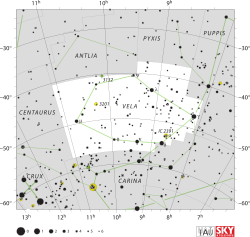HD 83368
| HD 83368 | |
 | |
| Observationsdata Epok: J2000.0 | |
|---|---|
| Stjärnbild | Seglet |
| Rektascension | 09t 36m 25,4069 s[1] |
| Deklination | -48° 45′ 04,2549″[1] |
| Skenbar magnitud () | +6,18 (v)[2] |
| Stjärntyp | |
| Spektraltyp | A8 V[1] |
| B–V | +0,27[2] |
| Variabeltyp | Snabbt pulserande Ap-stjärna |
| Astrometri | |
| Radialhastighet () | +4,0 ± 0,3[3] km/s |
| Egenrörelse (µ) | RA: -8,16 ± 0,03[4] mas/år Dek.: -18,85 ± 0,03[4] mas/år |
| Parallax () | 14,01 ± 0,03[4] |
| Avstånd | 232,8 ± 0,5 lå (71,4 ± 0,2 pc) |
| Absolut magnitud () | +1,94[2] |
| Detaljer | |
| Massa | 1,78+0,12-0,17[5] M☉ |
| Radie | 2,003[6] R☉ |
| Luminositet | 12,33[6] L☉ |
| Temperatur | 7 650[6] K |
| Vinkelhastighet | 33,8 ± 1,0[5] km/s |
| Ålder | 0,93+0,42-0,34[5] miljarder år |
| Andra beteckningar | |
| CCDM J09364-4845AB, CD-48 4831, CEL 3340, CPD-48 2558, GSC 08176-00283, HIC 47145, HIP 47145, HR 3831, PPM 314497, SAO 221339, TD1 14124, uvby98 100083368, ABV V*, IM Vel, WDS J09364-4845AB, Gaia DR1 5410092607368280448 [7][1]
HD 83368A: 2MASS J09362541-4845042, TYC 8176-283-1 HD 83368B: 2MASS J09362537-4845072, Gaia DR2 5410092611662456704, TYC 8176-2818-1 | |
HD 83368 (HR 3831) är en dubbelstjärna i den mellersta delen av stjärnbilden Seglet, som också har variabelbeteckningen IM Velorum.[1] Den har en kombinerad skenbar magnitud av ca 6,18[2] och är mycket svagt synlig för blotta ögat där ljusföroreningar ej förekommer. Baserat på parallax enligt Gaia Data Release 2 på ca 14,0[4] mas, beräknas den befinna sig på ett avstånd på ca 233 ljusår (ca 71 parsek) från solen. Den rör sig närmare solen med en heliocentrisk radialhastighet på ca -4 km/s.[3]
Egenskaper
[redigera | redigera wikitext]Primärstjärnan HD 83368 A är en vit till blå stjärna i huvudserien av spektralklass A8 V,[8] som är kemiskt speciell och visar fläckar med ökande koncentration av litium, europium och syre.[6] Den har en massa som är ca 1,8[5] solmassor, en radie som är ca 2[6] solradier och har ca 12 gånger solens utstrålning av energi[6] från dess fotosfär vid en effektiv temperatur av ca 7 700 K.[5] Stjärnan har ett enda men starkt förvrängt dipolpulseringsläge med en frekvens på μHz[9] och är en snabbt pulserande Ap-stjärna. Den har ett enda men starkt förvrängt dipolpulseringsläge med en frekvens på 1 427 μHz.[9]
HD 83368 är en dubbelstjärna med en projicerad separation på 3,29 bågsekunder och identifierades som sådan år 2002[10] Den har ett enda men starkt förvrängt dipolpulseringsläge med en frekvens på 1 427 μHz.[9]
Referenser
[redigera | redigera wikitext]- Den här artikeln är helt eller delvis baserad på material från engelskspråkiga Wikipedia, HR 3831, 27 mars 2022.
Noter
[redigera | redigera wikitext]- ^ [a b c d e] "HD 83368". SIMBAD. Centre de données astronomiques de Strasbourg. Hämtad 30 juni, 2021.
- ^ [a b c d] https://www.universeguide.com/star/46701/hd83368. Hämtad 2022-06-11.
- ^ [a b] Brown, A. G. A.; et al. (Gaia collaboration) (2021). "Gaia Early Data Release 3: Summary of the contents and survey properties". Astronomy & Astrophysics. 649: A1. arXiv:2012.01533. Bibcode:2021A&A...649A...1G. doi:10.1051/0004-6361/202039657. S2CID 227254300. Gaia EDR3 record for this source at VizieR.
- ^ [a b c d] Brown, A. G. A.; et al. (Gaia collaboration) (2021). "Gaia Early Data Release 3: Summary of the contents and survey properties". Astronomy & Astrophysics. 649: A1. arXiv:2012.01533. Bibcode:2021A&A...649A...1G. doi:10.1051/0004-6361/202039657. S2CID 227254300. Gaia EDR3 record for this source at VizieR.
- ^ [a b c d e] Sikora, J.; Wade, G. A.; Power, J.; Neiner, C. (2019), "A volume-limited survey of MCP stars within 100 pc – I. Fundamental parameters and chemical abundances", Monthly Notices of the Royal Astronomical Society, 483 (2): 2300–2324, arXiv:1811.05633, doi:10.1093/mnras/sty3105
- ^ [a b c d e f] Kochukhov, O. (2005), "Pulsational line profile variation of the roAp star HR 3831", Astronomy & Astrophysics, 446 (3): 1051–1070, arXiv:astro-ph/0509446, doi:10.1051/0004-6361:20053345, S2CID 13102520
- ^ HR 3831 (unistra.fr) Hämtad 2022-06-11.
- ^ "HD 83368B". SIMBAD. Centre de données astronomiques de Strasbourg. Hämtad 30 juni 2021.
- ^ [a b c] Bigot, L.; Kurtz, D. W. (2011), "Theoretical light curves of dipole oscillations in roAp stars", Astronomy & Astrophysics, 536: A73, arXiv:1110.0988, Bibcode:2011A&A...536A..73B, doi:10.1051/0004-6361/201116981, S2CID 54532822
- ^ Schöller, M.; Correia, S.; Hubrig, S.; Kurtz, D. W. (2002), "Multiplicity of rapidly oscillating Ap stars", Astronomy & Astrophysics, 545: A38, arXiv:1208.0480, doi:10.1051/0004-6361/201118538, S2CID 119311263
Externa länkar
[redigera | redigera wikitext]
| ||||||||||||||||
Text is available under the CC BY-SA 4.0 license; additional terms may apply.
Images, videos and audio are available under their respective licenses.





